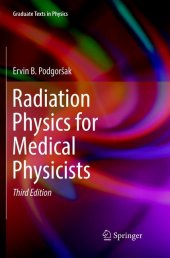 Neuerscheinungen 2018Stand: 2020-02-01 |
Schnellsuche
ISBN/Stichwort/Autor
|
Herderstraße 10
10625 Berlin
Tel.: 030 315 714 16
Fax 030 315 714 14
info@buchspektrum.de |

Ervin B. Podgorsak
Radiation Physics for Medical Physicists
3. Aufl. 2018. lviii, 906 S. 190 SW-Abb., 67 Farbabb., 100 Tabellen, 66 Farbtabellen. 235 mm
Verlag/Jahr: SPRINGER, BERLIN; SPRINGER INTERNATIONAL PUBLISHING 2018
ISBN: 3-319-79781-6 (3319797816)
Neue ISBN: 978-3-319-79781-6 (9783319797816)
Preis und Lieferzeit: Bitte klicken
This textbook summarizes the basic knowledge of atomic, nuclear, and radiation physics that professionals working in medical physics and biomedical engineering need for efficient and safe use of ionizing radiation in medicine. Concentrating on the underlying principles of radiation physics, the textbook covers the prerequisite knowledge for medical physics courses on the graduate and post-graduate levels in radiotherapy physics, radiation dosimetry, imaging physics, and health physics, thus providing the link between elementary undergraduate physics and the intricacies of four medical physics specialties: diagnostic radiology physics, nuclear medicine physics, radiation oncology physics, and health physics. To recognize the importance of radiation dosimetry to medical physics three new chapters have been added to the 14 chapters of the previous edition. Chapter 15 provides a general introduction to radiation dosimetry. Chapter 16 deals with absolute radiation dosimetry systems that establish absorbed dose or some other dose related quantity directly from the signal measured by the dosimeter. Three absolute dosimetry techniques are known and described in detail: (i) calorimetric; (ii) chemical (Fricke), and (iii) ionometric. Chapter 17 deals with relative radiation dosimetry systems that rely on a previous dosimeter calibration in a known radiation field. Many relative radiation dosimetry systems have been developed to date and four most important categories used routinely in medicine and radiation protection are described in this chapter: (i) Ionometric dosimetry; (ii) Luminescence dosimetry; (iii) Semiconductor dosimetry; and (iv) Film dosimetry.
The book is intended as a textbook for a radiation physics course in academic medical physics graduate programs as well as a reference book for candidates preparing for certification examinations in medical physics sub-specialties. It may also be of interest to many professionals, not only physicists, who in their daily occupations deal with various aspects of medical physics or radiation physics and have a need or desire to improve their understanding of radiation physics.
Introduction to Modern Physics.- Coulomb Scattering.- Rutherford - Bohr Atomic Model.- Production of X Rays.- Two-Particle Collisions.- Interaction of Charged Particles with Matter.- Interaction of Photons with Matter.- Energy Transfer and Energy Absorption in Photon Interactions with Matter.- Interactions of Neutrons with Matter.- Kinetics of Radioactive Decay.- Modes of Radioactive Decay.- Production of Radionuclides.- Waveguide Theory.- Particle Accelerators in Medicine.- Basics of Absolute and Relative Radiation Dosimetry.- Principles of Ionization Chamber Dosimetry.
"This book, now in its third edition, builds on his extensive expertise as a radiation physicist, medical physicist and educator, and constitutes a clear, comprehensive and well-balanced resource. ... the book is aimed at medical physicists, and it is indeed an excellent and comprehensive resource for students on Master´s and research degrees in this area or on clinical scientist training programmes, as well as for practising medical physicists." (Dr. Silvia Pani, RAD Magazine, October, 2017)


